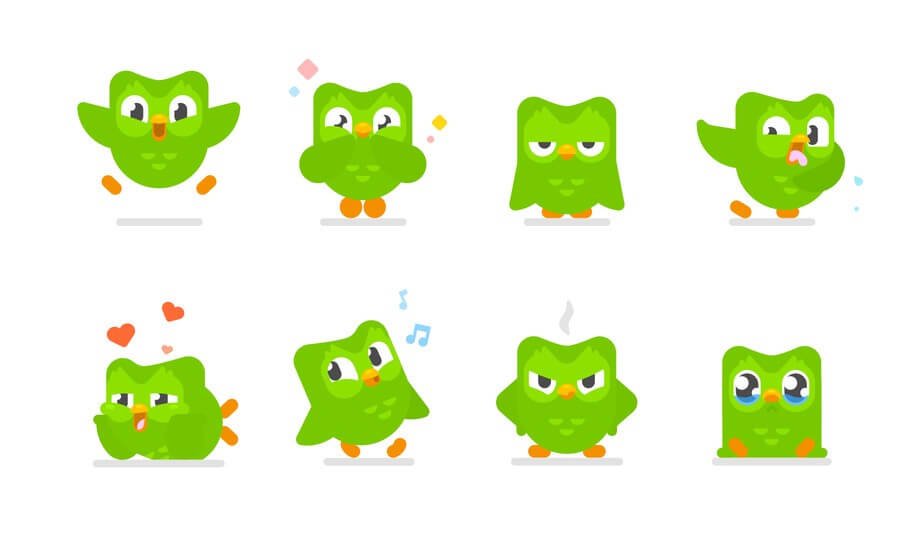As technology has evolved and the Internet has become ever-present, the e-learning industry has exploded. Now it is such a complex system of tools, technologies, players, and terms that it can be difficult to navigate it.
And when it comes to developing the language learning app, a whole series of practical questions arise. But no worries, in this article you will find detailed answers to all of them.
2 Main Types of Learning Apps
In the case of e-learning, students receive educational content through a computer, tablet, or smartphone. Learning content involves a series of slides with audio/video accompaniment of the author, PDF files, videos, screencasts (screen recordings), simulation programs, or interactive courses with a slide structure.
As a rule, applications for e-learning can be divided into two types. It depends on the type of user: students or teachers. There are not as many variations of applications for teachers as there are for students.
However, for teacher applications, the following elements need to be highlighted:
- Convenient user experiences for creating courses, and tests;
- The interfaces of communication with individual students, groups of students;
- Access to the list of subjects they teach;
- Opportunity to check the learning materials sent by students, to give grades.
When developing student applications, the following requests should be considered:
- Access to the system from any device;
- Mobile app development for learning (a separate trend – mobile learning, m-Learning);
- Multimedia formats, gamified features (especially for children and adolescents);
- The user interface of communication with the teacher, the ability to quickly contact and discuss issues of interest;
- Convenient interfaces of courses, lessons, and tests;
- The clear evaluation system, and opportunity to see your progress;
- A quick way to find out which lesson needs to be completed in the first place.
Read also: An Innovative Strategy to Improve Learning Efficiency
See how to better combine learning process with technologies
The Most Popular Language Learning App

Here we’ll review the second type of educational application – for students. Our reference point will be the Duolingo language learning application.
Recently, various online learning systems, from Duolingo to Coursera and Udemy, are actively gaining more and more popularity. Many of them switch to the format of game training and introduce a large number of gamified elements. This helps to attract more and more users and makes the process of learning vivid and memorable for them.
Duolingo is the most popular platform for learning foreign languages and the most downloaded educational application in the world. It is considered to be a leader among such tools. For a good reason in 2013, the application became Apple’s choice for App of the Year. Right away after that in 2014, Duolingo was named the most downloaded app in the Education category in Google Play.
The company’s mission is to make training free, fun, and accessible to everyone. And the creators are fully committed to this principle.
The training program is divided into lessons arranged in order of complexity and, after the initial level, devoted to individual topics. Each lesson contains different types of exercises for translation, reading, writing, and listening. It’s designed to study grammar rules or new vocabulary in the context of live speech.
At any stage, training is available to merge the acquired knowledge. The format of the game is represented by different elements. Specifically, experience points, levels, rewards, and game currency for the purchase of extra features and bonuses in the store.
To track the regularity of classes, you can set a daily goal and set up reminders for e-mail. For the further development of skills, the Stories project has been opened. Here you need to perform interactive tasks as part of the voiced situational dialogue.
The variety of application features is amazing. No wonder, in 2019 Forbes named Duolingo “Next Billion-Dollar Startups 2019″.
5 Clues on How to Create a Successful Language Learning App Like Duolingo
So, what does it take to make your native app as successful as Duolingo’s?

When developing your dream project, you should consider the following parameters:
#1. Elements of Gamification
Nowadays, the learning process is moving away from boring and standard schemes. It’s becoming more and more gamified. So think about introducing a system of bonuses, achievements, and awards that would support the users’ interest and emotionally involve them.
#2. Nice Design and Ease of Use
Everyone loves the services with intuitive navigation and a simple and interesting interface. In order not to complicate the process of familiarization and use of your application, it is worthwhile to think through the design of the application, and the style of content design, and provide a structured and convenient UX.
Create tips, a chatbot, or a support group, in case the user does not understand what further actions should be taken during the training.
#3. Integration With Social Networks
This element of application development will help simplify the registration process and reduce the time a person takes to fill out their data. For greater effectiveness, take social networks such as Facebook, Google, etc.
#4. iOS and Android Versions
There is no doubt that users can use different platforms. So in order not to cross out part of the audience, it is worth providing access to the e-learning application from different devices. For that, you should consider planning Android app development and iOS app development.
#5. Variety of Format
Duolingo stands out among other educational applications with a wide selection of content. Only the completeness of the content can prove to users that with your application they are guaranteed success in learning.
Our Example of Education App

Creating an educational app is an exciting experience, that we at Visartech have been through while working on the FluffyWords project. It’s a word game with the main goal to collect more words than the opponent and get ahead of him or her by the number of points.
The application has a positive impact on players, as it develops the speed of thinking and has many gamified elements. Among them are playable characters, different categories, such as “animals” and “cities & countries”, and musical sensation, that captures the player and makes the process of learning words bright and interesting.
There are a lot more educational projects that we’ve been working on – just take a closer look at our expertise page.
Top 9 Features of Duolingo-like Language Learning App
After studying the necessary parameters, we move on to the functionality (MVP) of the future application.

Using Duolingo as an example, we can safely distinguish the following components:
#1. Registration / Log-In Form
To do this, users need to give short answers to questions about themselves (name, e-mail, gender), and create a login and password. Logging in should also include the ability to log in via social networks for greater convenience.
#2. Personal Profile
Users should be able to fill out all the stream information about and monitor their progress: personal data, the language that they want to learn, the current level of the language, and daily/monthly goals.
#3. Courses
Namely, the list of courses that are in progress, completed, available, and even those that the user can open only after the purchase of a paid subscription. For any language application, the necessary part is precisely the set of courses that are available to the client. The wider the variety of courses, the higher the value of the application.
#4. Trackers of Progress
People admire to celebrate their achievements. So the toolbar of the training application should include awards (similar to crystals in Duolingo), that can be exchanged for some bonuses; levels of mastery of certain skills, or a tracker to achieve their goals (user progress is noticeable by the number of experience points that they gain for completing tasks).
A very useful thing is the icons that testify to the regular use of the application (in Duolingo it is a flame of knowledge, that you can “ignite” using the application daily). The daily/weekly ratings of the course participants are also very motivating to learn the language without long breaks.
#5. Audio and Video Streaming
The main feature of the application is the content that it supports. Learning languages is easier when there are different exercises for listening to the audio, watching videos, reading and translating texts, progressing in pronunciation and games, etc. The wider the amount of material for developing knowledge, the better.
Read more: A Detailed Guide To Developing A Social Media App Like Clubhouse
Discover the key steps to create a voice-chat social network
#6. Integration With Social Networks
The ability to invite Facebook friends to the application, or share achievements on your page. All this increases the interest of existing users and attracts new ones.
#7. Push Notifications
They are necessary as an additional factor in motivating users to complete the course, fulfill daily goals, etc.
#8. Forum
This is a place where users of the application can get together and ask each other for help, find like-minded people, and share their emotions about the learning process. The forum is an important feature of the training application. It forms the necessary network, increases the emotional attachment to the app (due to the interlocutors found and the assistance provided), and even develops some kind of replacement for social networks.
#9. Testing Knowledge
Namely, the presence of various tests that complete the course/topic of exercises is a great method of user control that checks their knowledge and skills. Without the implementation of this function, the value of the application for the user may fall, since they will not notice the desired effect from using it.
How Much Does It Cost to Develop a Language Learning App Like Duolingo?

The estimations of learning app development may vary from one software development company to another.
It depends on many factors like:
- the structure of the development team;
- tech stack at their disposal;
- geographic location;
- level of overall tech expertise;
- the number and complexity of app features
- the application type (native or hybrid app).
So the learning app development cost greatly depends on the number of hours that the app development team allocates for the specific application development multiplied by the hourly rate of their specialists. Depending on geographic location and professional expertise the rate varies from $25 to $150 per hour of work.
Let us share our rough estimation of an education application development like Duolingo. We will start with the estimate of the frontend development of the web application.
| Tasks/Features | Optimistic, hours | Pessimistic, hours | Time, hours |
| Documentation | 48 | 72 | 60 |
| User Interfaces design | 80 | 120 | 100 |
| Design implementation (screens development) | 64 | 96 | 80 |
| Multiple resolutions support | 56 | 80 | 68 |
| Core logic | 120 | 160 | 140 |
| Testing | 56 | 96 | 76 |
| Domains/DNS setup and publishing | 24 | 40 | 32 |
| Total | 448 | 664 | 556 |
As you can see, the frontend part of such a web application may take from 448 to 664 hours of development. So if you take the most common web development rate of $50 per hour, the frontend development cost of such an educational app will be from $22,400 to $33,200.
Read more: How to Save Money on a Web Project for Businesses
Learn how to select the best tech stack for your web application
Let’s see the total Duolingo cost estimation of other parts: the backend development, the frontend development for a mobile application, and the actual content production with exercises within the app.
| Tasks/Features | Optimistic, hours | Pessimistic, hours | Time, hours |
| Backend | 456 | 816 | 636 |
| Frontend (mobile apps) | 416 | 648 | 532 |
| Content & exercises | 640 | 1040 | 840 |
Again, with the rate of $50, these education app development stages will cost:
- Backend: $22,800 – $40,800;
- Frontend (mobile apps): $20,800 – $32,400;
- Content & exercises: $32,000 – $52,000.
So how much does it cost to build an app like Duolingo?
The total Doulingo cost varies from $98,000 to $158,400 with an app development rate of $50 per hour.
How long does it take to create an education app like Duolingo?
If you translate the estimated hours into the usual working time, it will take from 49 to 79 weeks. Basically, the development time is from around a year to a year and a half. So if you have plans to create such an application you should better start shortly.
What is the structure of a development team that can create an app like Duolingo?
The above-specified estimation was counted based on the following development team structure:
- Project Manager
- Business Analyst
- System Architect
- Art Director
- Web Designer
- 2D Artist
- 3D Artist
- SFX Composer
- React Native Lead
- React Native Developer
- .NET Lead
- .NET Developer
- DevOps
- QA
So you need people with these professional skills to make such an app a reality.
Read also: Behind the Scenes of Development Process: The Visartech Workflow
Learn the methods of organizing effective workflow that we apply at Visartech
If you wish to see a more detailed estimation of the last three mentioned software development stages, just leave us a message and we will send you our full estimation of a Duolingo cost.
Сonclusions
Creating the language learning app is not easy, but it is very real and potentially successful with proper planning and a responsible approach to its implementation.
The main steps that you must follow when stepping on this path:
- decide on the format of your education application;
- plan all the necessary details;
- make a list of requirements for the implementation of your application;
- hire app developers who will help you with the implementation of your idea;
- provide marketing support and market promotion of the learning application.
The founders of Duolingo once said:
“The main factor of success is the attitude to mistakes. If you’re not afraid to look stupid, you’ll do much better.”
Luis von Ahn (CEO) & Severin Hacker (CTO)
We completely agree with them because people draw experience from mistakes.
But we want to help you avoid mistakes as long as possible. That’s why we wrote this article, hoping that it will become your guide in creating your own educational application.
And if you wish to start right away, let’s create an educational app together!




